International Dance Day 2024
I cannot think of a more joyous April sendoff than art that features dancing in celebration of International Dance Day. The International Theater Institute began International Dance Day on April 29, 1982, as a celebrate the 255th birthday of the founder of modern ballet, Jean-Georges Noverre (1727–1810). According to the International Theater Institute, “The intention of the International Dance Day Message is to celebrate dance, revel in the universality of this art form, cross all political, cultural and ethnic barriers, and bring people together with a common language - dance.”
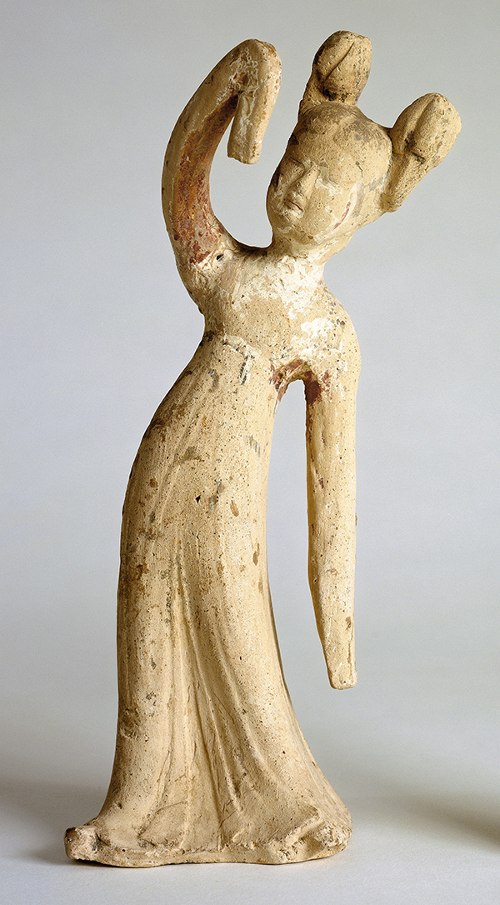 |
| Unknown artist, Tang Dynasty, China (618–907 CE), Dancer, tomb figure, 600s–700s CE. Earthenware with pigment traces, height: 9 ¾" (24.76 cm). © 2024 Buffalo AKG Art Museum, Buffalo, NY. (AK-269) |
From the earliest Chinese dynasties up until the end of the Qing (1644–1911), people in China believed that the afterlife was a continuation of earthly life after death. During the Shang (ca. 1523–1028 BCE) and Zhou dynasties (ca. 1046–256 BCE), bronze vessels were included in tombs so the deceased could continue making offerings to their ancestors. It was also a practice to kill and bury valued servants with the deceased. During the Han Dynasty (206 BCE–220 CE), this practice was replaced with ceramic figures that represented types of servants in tombs.
Such elegant, courtly figures were meant to accompany the deceased and provide perpetual entertainment in the afterlife. They convey valuable information about Tang dynasty (618–907 CE) culture, including clothing, hairstyles, interests, entertainment, and some understanding of social classes. Such performer figures were usually placed along the sides of the platform on which the sarcophagus of the dead rested. The figures were painted and sometimes glazed. Wooden examples of these companions to the dead would have had painted features and cloth garments.
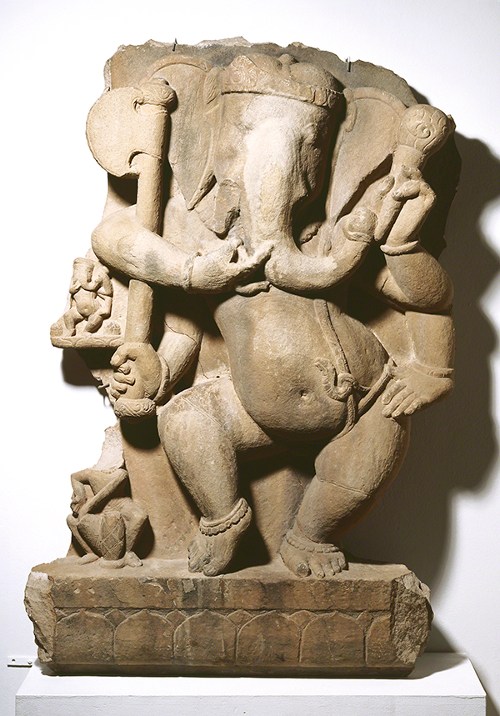 |
| Unknown artist, India, Ganesa (or Ganesha) Dancing, ca. 750 CE. Sandstone, height: 50" (127 cm). © 2024 Philadelphia Museum of Art. (PMA-2810) |
Ganesa is called Lord of Hosts (ganas, or nature deities). He is also known as the Lord of Obstacles, because he helps those who worship him overcome them. One of the most popular gods in the Hindu pantheon, Ganesa is invoked at the beginning of every undertaking to ensure success. He has been described as the embodiment of gentleness and the “abode of auspiciousness.”
This sculpture of Ganesa was probably meant to decorate a temple. The dance of Ganesa, in contrast to his father Siva’s dance of creation and destruction, emphasizes his playful (childlike) nature. The elephant head is always depicted on the body of a male toddler with an exaggerated, distended stomach, which contains numerous nefarious threats that he has swallowed, like the demon Analasura. As a remover of obstacles, Ganesa clears a path to worship of Siva.
Ganesa was the son of Parvati, consort of the god Siva, whom she wooed in his avatar of Siva the Ascetic. Because Siva the Ascetic did not want to procreate, Parvati fashioned a son out of the soap scum and oils in her bath water, making him the guardian of her bedroom door. Once when Siva wanted to enter, Ganesa blocked him, and Siva cut off his head. The other gods were asked to replace it with the head of the first being they met. Encountering an elephant, they cut its head off and placed it on Ganesa’s toddler body.
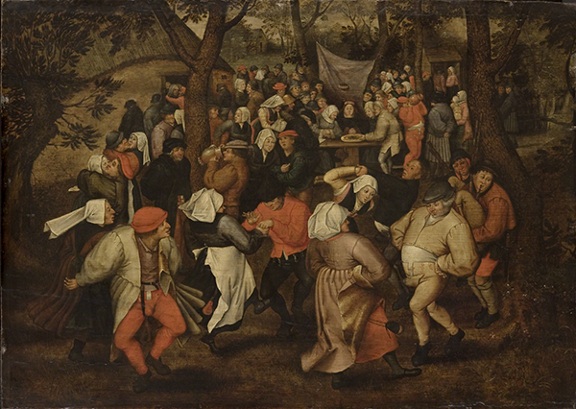 |
| Pieter Brueghel, the Younger (1564–1637/1638, Flanders), Wedding Dance in the Open Air, ca. 1600. Oil on wood pane, 14 ⅞" x 12 ⅞" (37.8 x 32.7 cm). © 2024 Philadelphia Museum of Art. (PMA-9592) |
Wedding Dance in the Open Air is a more compact version of a painting by Pieter Brueghel the Younger’s father, Pieter Bruegel the Elder (1525–1569)—The Wedding Dance (1566) located at the Detroit Institute of Arts. It represents the Late Renaissance Flemish genre style. Bruegel the Elder is the artist who almost single-handedly elevated genre painting to the status it achieved. In the Wedding Dance paintings, a country marriage celebration is attended by local rural folk. While the bride is easily visible seated at the feast table in the background, it is hard to determine who the groom is. This was one of the key features of both versions of the paintings.
The younger Brueghel emulated his father's forms, but the figures are flatter and the lighting of the scene less atmospheric. The background also resembles the works of the elder Bruegel. There is less of an expansive background than in the earlier work. The dominant palette of warm and cool earth tones, even down to the peoples’ clothing, reflects that this is a subject that lauds the rural class as hard workers by day and hardy partiers at weddings. Like his father, Brueghel the Younger seems to have had a genuine affection for the people he and his father studied and depicted.
Brueghel, the Younger, was a pupil of the Romanist Gilles van Coninxloo (1544–1607), who applied Italianate principles to genre paintings, as well as to the evolving subject of dedicated landscape. While he is most famous for copies he did of his father's encyclopedic paintings, he also distinguished himself in genre scenes of country people. His patrons were predominantly private and he received no church commissions.
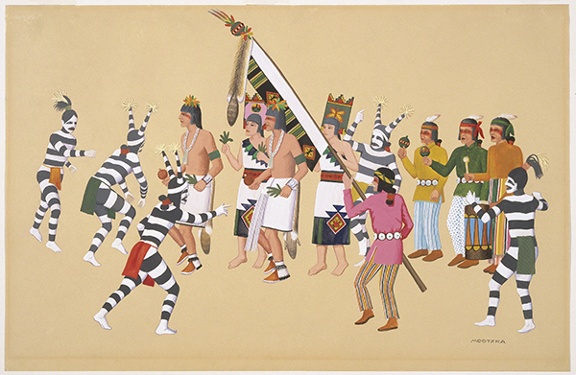 |
| Waldo Mootzka (1903–1940, Hopi Pueblo, Arizona), Fall Corn Dance, 1938. Opaque watercolor and pencil on paper, 13" x 20" (33 x 51 cm). Image © 2024 Brooklyn Museum. (BMA-4916) |
In the spring, the Hopi Corn Dance celebrates the planting of corn, an important crop to the Pueblo peoples. The autumn Corn Dance, depicted in this painting by Waldo Mootzka, celebrates the harvesting and shucking of the corn. A person holds a rain staff in the painting because rain is vital for growing healthy crops. There are four corn dancers, surrounded by clowns who are mischief-makers.
Like most Santa Fe School artists, Mootzka omits the background setting to focus on the Hopi traditional dance. The goal of Santa Fe School artists like Mootzka was to preserve the vanishing customs of Native American cultures. Mootzka was influenced by Katsina (Kachina) ceremonies in creating his figures, and he was meticulous about including the details of traditional costume and attitude. Despite the figures' stiff poses, they convey a sense of the dignified gravity of the traditional dance.
Mootzka was born in Oraibi, Arizona, a Hopi village on the Third Mesa. He attended Oraibi Day School, where he observed the well-known Hopi painter Fred Kabotie (1900–1986). Kabotie attended the Santa Fe School, where he was mentored to embrace his Hopi heritage in his art. Mootzka also studied at the Santa Fe School and adapted stylistic elements of Kabotie’s work. He also produced individual Katsina paintings and became a master silversmith.
During the early 1900s, there was an effort by well-meaning anthropologists and intellectuals to begin a painting tradition for Navajo and Pueblo artists. These thinkers believed that many traditions of Native American life were vanishing and needed to be documented in pictorial form. In 1899, works were commissioned from several Hopi men for display outside the community. A few years later, several other Pueblo artists began making paintings for sale to outsiders. By the late 1920s, many Pueblo artists were experimenting with painting and drawing scenes of traditional Pueblo life.
The pictorial movement was catalyzed by the establishment of a formal painting program at the Santa Fe School in 1932. The Studio, a painting program for high school-aged students, was launched by non-native teacher Dorothy Dunn (1903–1991). Dunn did not teach Western painting concepts such as perspective, volumetric form, or composition, insisting that students rely on the traditional arts of Pueblo cultures. The Studio was characterized by a flat, stencil-like style with minimal background that stressed subject matter.
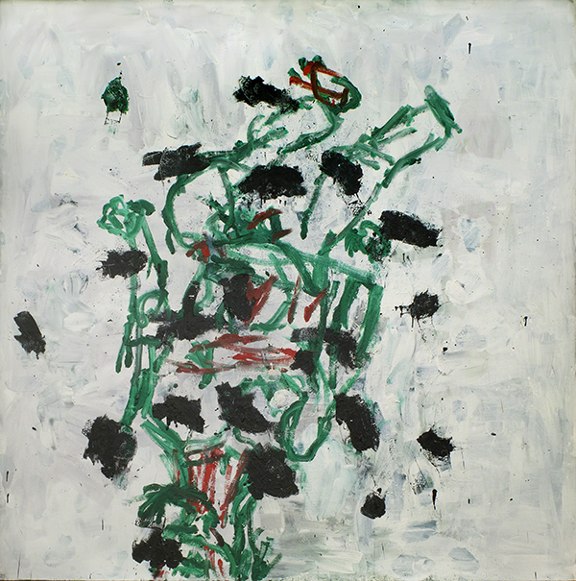 |
| Georg Baselitz (born 1938, Germany), Vienna Ballet, 1990, Oil on canvas, 9'6" x 9'6" (289.9 x 289.9 cm). Courtesy of the Philadelphia Museum of Art. Permission for reproduction granted by the artist. © 2024 Georg Baselitz. (PMA-9382bl) |
Typical aspects of Georg Baselitz’s paintings are jagged, gestural contour lines; varying degrees of both thin and thick impasto; often jarring color; enigmatic, if not nonexistent, narrative; and, of course, figures that are depicted upside down. The painterliness of his works was influenced by Willem de Kooning (1904–1997), an American Abstract Expressionist whose work his saw in a touring exhibition in 1958. Baselitz was also inspired by the freedom of brushstroke that he saw in the late 1950s. Beginning in 1969, presenting figures upside down enabled Baselitz to free himself from traditional painting concerns. It allows the viewer to focus on elements of art such as line, shape, and color, rather than a resemblance to nature. Baselitz actually paints these figures upside.
The compositions Baselitz creates may seem brutal to some people, even in such innocuous titles as Vienna Ballet. This work depicts a dancer whose form is overlaid with footprints that may represent the steps of a dance. The artist’s connection to dance in Vienna was reprised in 2023 when he designed a poster the Vienna Opera Ball.
Baselitz was born Hans-Georg Kern during Nazi-era Germany (1933–1945) in Deutschbaselitz, Saxony, which became part of East Germany after 1945. From a young age, he was interested in German Expressionism and so-called “primitive” sources such as non-Western art, Visionary Art, and children's art. He was part of a generation of young German artists in the 1960s who were children during World War II (1939–1945). Because their formative years took place in the condemnation and partitioning of Germany due to the country's war crimes, these young artists rejected abstraction in favor of expressive paintings in recognizable subject matter to underscore what they saw as the insanity of Germany's actions during the war.
First studying art at the Academy of Art in East Berlin (1956–1957), Baselitz graduated from the Academy of Fine Arts in West Berlin (1957–1962). After graduating, the artist adopted the name “Baselitz.” He also adopted the slashing brushwork and vivid color of German Expressionism. Baselitz employed a deliberately crude style to render sheer emotion. During the 1960s, Baselitz’s subjects were figures from mythology, rebels, and shepherds. He established his signature style of heavy impasto, often fragmenting figures, and using shocking or disturbing images to evoke a reaction from viewers.


Comments